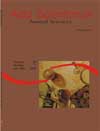Effects of substitution levels of corn by <em>citrus</em> pulp on apparent digestibility in feedlot bulls
Abstract
This experiment was carried out to study the apparent digestibility coefficient of dry matter, organic matter, crude protein, gross energy and neutral detergent fiber of four diets with different substitution levels (40%, 60%, 80% and 100%) of corn, as energy source, by citrus pulp fed to crossbreeding bulls (F1) in feedlot. Besides corn and/or citrus pulp, as energy source, the animals were fed with corn silage, soybean meal, meat and bone meal, as protein source, and bicalcic phosphate, limestone, mineral miture and monensin. Twenty-eight crossbreeding bulls with about 20 months of age and 346 kg of live weight were alocated in a complete randomized design, with four diets (citrus pulp levels) and seven replications. The animals were housed in 10m2 pens and fed ad libitum. Insoluble acid ash was utilized as internal indicator. Remainder and feces were collected from all animals in the pens with a long spoon for 7 days, after 28-day adaptation. The dry matter, organic matter, crude protein, gross energy and neutral detergent fiber digestibility apparent coefficients for diets with 40% and 100% of citrus pulp were similar and higher than the values obtained for substitution levels of 60 and 80%. Thus, the best equations to describe the apparent digestibility coefficients for substitution levels of corn by citrus pulp were the quadratic ones.Downloads
Download data is not yet available.
Published
2008-05-13
How to Cite
Pinheiro, A. D., Prado, I. N. do, Alcalde, C. R., Zeoula, L. M., Nascimento, W. G. do, & Torii, M. S. (2008). Effects of substitution levels of corn by <em>citrus</em> pulp on apparent digestibility in feedlot bulls. Acta Scientiarum. Animal Sciences, 22, 793-799. https://doi.org/10.4025/actascianimsci.v22i0.3197
Issue
Section
Animal Science
DECLARATION OF ORIGINALITY AND COPYRIGHTS
- I Declare that current article is original and has not been submitted for publication, in part or in whole, to any other national or international journal.
The copyrights belong exclusively to the authors. Published content is licensed under Creative Commons Attribution 4.0 (CC BY 4.0) guidelines, which allows sharing (copy and distribution of the material in any medium or format) and adaptation (remix, transform, and build upon the material) for any purpose, even commercially, under the terms of attribution.
Read this link for further information on how to use CC BY 4.0 properly.
0.9
2019CiteScore
29th percentile
Powered by 








































